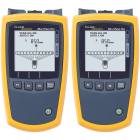Finding the keys to success in the MPO datacenter
January 10, 2013 / General
As companies try to address the rising demand in IP traffic in order to support a growing array of business applications, many are designing their data centers with fiber optic networks that support 10G or 40G Ethernet connections between servers, switches and storage area networks, and 100G Ethernet for core switching and routing backbone connections. At the Interop 2012 conference in May 2012, the Ethernet Alliance, a global consortium dedicated to the advancement of Ethernet technologies, hosted an interoperability demonstration that highlighted 10G and 40G Ethernet’s seamless interoperability, which it said gives Ethernet “the unique ability to support cloud computing, convergence, and virtualization in the data center.” To optimize their use of fiber in the data center, many organizations are deploying multi-fiber push-on (MPO) cabling systems. MPO, a fiber optic solution specifically designed for data center environments, uses ribbon-fiber cables and usually has six or 12 cores housed in a single high-density MPO connector. MPO cables can fan out to other connectors to interconnect with standard-density products or services, generally using 12 or 24 fiber cassettes. MPO systems offer numerous potential benefits for organizations. Among these are the reduced amount of rack or floor space needed in data centers; dramatically reduced time to install networks as well as reduced labor and installation costs; greater density (more fiber pairs per 1U panel) and therefore increased efficiency; easier network scalability; and reduced energy consumption and costs because MPO connections require less electricity. An additional benefit is that MPO cassettes can be easily moved around, so it’s not hard to make changes and upgrades within the network as needs shift. But it’s important to keep in mind that there are challenges involved in deploying MPO connections. When you are installing an MPO link with cassettes at each end, any problems that crop up are made even worse if you do not have proper diagnostic equipment in place. The process at the moment is to keep swapping out the cassettes until the system works. But if you think about it, in a typical scenario this means you test once and if it fails, you need replace the cassette at one end. Then you test again and if that did not fix the problem, you replace the cassette at the other end. Then you test again and if that does not resolve the issue you try another MPO trunk cable, and then test again. If you use a purpose built tester like the MultiFiber Pro, testing MPO cabling need not be as challenging as can be with testers designed for simplex and duplex fiber cabling. The MultiFiber Pro will connect directly to 12 fiber MPO trunk cables and automatically verify the polarity of the cabling being tested. As you can see this can be a time-consuming and labor-intensive effort. Its a myth that you can't use OTDRs for troubleshooting in the Datacenter. In fact, you need to have a tool such as an optical time-domain reflectometer (OTDR) on standby. But its got to be one capable of operating in a connection rich environment and be set up for testing in datacenters. An OTDR, such as the OptiFiber Pro from Fluke Networks, was designed to characterize an optical fiber in this environment. It can be used to estimate the fiber length and overall attenuation, including splice and mated-connector losses. It can help locate faults such as breaks and measure reflectance and optical return loss in datacenters. If you are building an MPO link with cassettes at each end and you cannot get it to pass, consider using an OTDR that can tell you which end is causing the difficulty. Then it becomes a matter of replacing the cassette and you are good to go.







